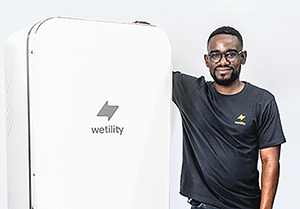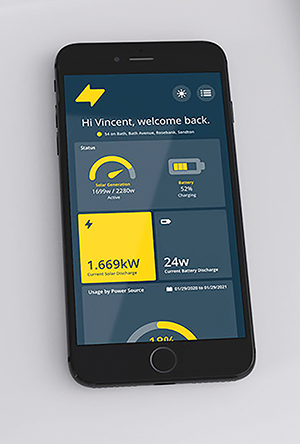
South Africans need a reliable power solution now. Confronted with load-shedding, power outages and price hikes, there is a real sense of urgency around securing a reliable power solution capable of operating for extended periods of time.

Production at the point of consumption is an obvious solution for individual residential consumers. To support remote work and home businesses, most residential customers have resorted to generators, uninterrupted power supplies (UPSs), inverters and batteries, but all these solutions have their limitations.
Generators are noisy and costly to run for extended periods. UPSs, inverters and batteries alone cannot last through days of power outages. Those with the resources have long since turned to solar – or photovoltaic (PV) systems – as a long-term solution. How does the rest of the country benefit from the solution and how can access become a reality for everyone?
The solar solution
With most areas of South Africa averaging 2500 hours of sunshine a year and high solar irradiation levels of between 4,5 and 6,5 kWh/m2 per day, solar simply makes sense. The situation is similar across southern Africa and the company has the bold vision of finding a Wetility PV system at every home in the SADC.
A rooftop PV system is relatively quick to install, it is clean and it pays for itself in the long term. But until fairly recently, the upfront costs have priced this option out of reach of most South Africans.
We have now reached a point at which ordinary South Africans can afford to start the solar journey, with lower-cost components and new lease-to-own systems putting rooftop solar PV systems within reach of millions more people.
The US National Renewable Energy Laboratory (NREL) reports that the cost of PV system components has dropped by as much as 80% over the past decade, while at the same time, the technology has become more efficient. This trend is continuing, making these systems a viable proposition for suppliers and residential customers, as well as for financiers who may have seen them as a high-risk investment and an asset that does not retain resale value.
First steps to power independence
This changing environment has set the scene for companies such as Wetility to emerge, aggregating hundreds of distributed home systems into a plant comparable to a commercial or industrial plant. By using quality products that stand the test of time, Wetility is de-risking the entire process for the lender, enabling customers to benefit from economies of scale.
Taking this a step further, Wetility can now make the technology available to customers with no upfront costs – they have the option of a simple power purchase agreement or fixed monthly lease. This puts potentially millions of households on their first steps towards complete off-grid independence.
Hybrid first
While off-grid may be the goal of many, Wetility recommends going hybrid first. This is because rooftop PV components have an expected lifespan of 15 to 25 years and we have to remain cognisant of the fact that PV costs will continue to come down and the technology will continue to improve.
A hybrid solution uses both solar energy and grid power, ensuring that the home has sufficient power, even for appliances that require a lot of power and batteries store power for use during load-shedding and outages. The sun charges the battery during the day and after dark, it powers the home for six to eight hours, depending on the home’s consumption. When the battery is drained, the system switches over to the grid. Because solar power is brought into the equation, the use of grid power may decrease by as much as 60%.

Wetility uses lithium-ion batteries rated for a life of 6000 cycles, depending on various factors, such as ambient temperature and where the equipment is installed, but generally the rating means that the batteries would degrade to a state of health somewhere around 70% to 80% (down from 100%) after 12 or 13 years.
Batteries are quite replaceable, costs continue to drop by 5% or more per year on average and life rating continues to increase on new models every year. On Wetility lease options there is the option to include replacement of batteries as well.
With a hybrid solar solution instead of a complete off-grid solution at this stage, customers will have greater power security and be able to keep the lights on during outages, as well as enjoy double-digit cost savings on utility power from day one.
However, they won’t have to make what remains a significant financial commitment at this stage. They can scale and build on their modular system over the years as their needs – and the environment – change. This starts customers on an energy journey that is efficient and cost-effective, that grows with them and continues to improve their lives over the long term.
Solar questions and answers
Solar PV is priced out of reach of ordinary consumers: five years ago, solar – or photovoltaic – systems may have been prohibitively expensive for most residential customers and required a significant upfront investment. However, the price of PV system components is dropping fast and new business models allow consumers to lease-to-own or enjoy solar-as-a-service with no upfront cost.
Solar is the silver bullet for off-grid living: rooftop PV systems are certainly part of the solution to power instability and rising costs. However, solar power is not yet an ideal solution for power-intensive appliances like ovens, stoves or irons. This means that homeowners going off-grid would need to look at alternatives such as gas for cooking. At this stage, grid power remains a safe and relatively affordable choice for cooking, which is why Wetility believes a hybrid solar/power utility system offers the best of both worlds – cost-effectiveness and reliability.
Solar only works in daylight: solar PV technology has become more efficient in recent years, so that systems can now also perform on cloudy days. The power generated during the day will allow you to run many appliances without utility power. With efficient storage (batteries) as part of your PV system, you will also be able to store solar power for use at night or during load shedding.
How can I be assured of good quality: Wetility offers a five-year maintenance warranty on workmanship and a 10-year warranty on the heart of the solution – PACE, which includes a hybrid inverter, lithium-ion batteries and switchgear. We also guarantee 24/7 monitoring and support. The Wetility solution comprises:
• Solar panels that are made of monocrystalline photovoltaic cells that convert sunlight to direct current.
• The PACE, Wetility’s hybrid energy storage system consists of three main components: an inverter, solar battery(ies) and switchgear. The inverter takes the DC electricity produced by your solar panels and turns it into alternating current (AC) for use in your home. The inverter charges your solar batteries with energy produced by your panels and intelligently discharges energy from your solar batteries to meet your home’s needs. The switchgear contains electrical disconnect switches, fuses and circuit breakers used to control, protect and isolate electrical equipment. It also intelligently controls the distribution of power from the solar panels and solar batteries without the homeowner touching any manual switches.
• The Smart Meter in the PACE solution housing unit monitors the system production and the house’s electrical consumption, constantly sending this information to the PACE and Wetility’s customer care team remotely through a wireless signalling system.
• The distribution board. Solar electricity from your inverter flows to the distribution board and then into the home where it powers lights and appliances. If the panels generate more solar energy than you use, the excess power will flow to the batteries for later use.
• The We-X digital interface allows customers to view the financial and technical performance of their system via a web and mobile application.

© Technews Publishing (Pty) Ltd. | All Rights Reserved.